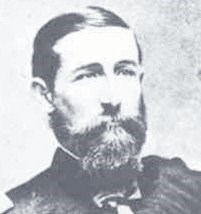Commanding OfficersCapt. Julius Hayden, Fort Larned's fifth commanding officer, arrived at the post on April 19, 1861, bringing with him a herd of cattle to provide fresh beef, as well as 67 officers and men of the Second U.S. Infantry as garrison reinforcements. Capt. Hayden relieved Lt. Beall as post commander and set about establishing a new duty rotation for the soldiers. Hailing from New York, Julius Hayden was commissioned a 2nd Lieutenant in the 2nd U.S. Infantry on January 16, 1839. Seven years later he achieved the rank of 2nd Lieutenant on June 18, 1846, and captain four years later on June 30, 1850. Before receiving the permanent rank of captain, he earned a brevet promotion to that rank in the Mexican War for gallantry and meritorious conduct at the battles of Contreras and Churubusco. |

Public Domain The summer of 1861 was a busy one for the officers and men of Fort Larned. Besides providing escort duty along the Santa Fe Trial they operated a horse-powered sawmill about 18 miles above Fort Larned to provide lumber to the fort. Capt. Hayden also had to convene a Council of Administration with the officers under his command to dispose of the personal and public property of a deceased soldier, as well. Soldiers from the fort also rescued the members of a Mexican wagon train who had been attacked by a band of Arapahos, led by an Indian named Big Mouth. The soldiers who took part in the rescue mission captured one of the Indians and held him hostage for the safe return of 25 oxen stolen during the raid. The Indians returned the animals, and the soldiers released the hostage. Although able to help in this instance, Capt. Hayden wrote a letter to the Indian Agent at Fort Wise explaining that he had a limited number of men under his command and would not be able to adequately protect travelers along the trail without the agent's help. "Keep your Indians off the road by seizing and holding Big Mouth and 15 to 20 of his warriors!" The outbreak of Civil War in the spring of 1861 depleted the frontier forts of almost all available fighting men right at the time the Santa Fe Trail was reaching the height of its commercial importance. By the summer of 1861 there were fewer than 300 soldiers between Fort Larned, Kansas and Fort Laramie, Wyoming. Despite the shortage of soldiers, escort and patrol duties continued at frontier posts, including Fort Larned. It was during Capt. Hayden's tenure as post commander that Indian Agent Albert G. Boone out of Fort Wise, Colorado suggested that Fort Larned become a distribution point for Indian annuities. There were several reasons to consider Fort Larned for this role. The main was its location roughly halfway between Forts Riley and Wise, which meant that transportation costs for the goods could be substantially lowered. There were also large herds of buffalo in the area, and ample storage space at Larned. Another good reason, from Agent Boone's perspective, is that going to Fort Larned would place the Indians of his agency, mostly Cheyenne and Arapaho, further away from the Utes, their traditional enemies. Capt. Hayden was promoted to Major on February 15, 1862, and transferred to the 10th U.S. Infantry out of Fort Lyons, Colorado, in August 1862. His replacement, Captain Daniel S. Whittenhall of the Second Kansas Volunteers, had already arrived in June. Like many active-duty army officers, Maj. Hayden was eventually recalled east during the Civil War and served in that conflict with distinction, receiving two brevet promotions. The first was to Lt. Col. in 1864 for service in the Battle of Chancellorsville, the second to Brig. Gen. for gallant and distinguished service in the field. After the war he achieved the permanent rank of Lt. Col. of the 15th Infantry in July 1866. He died on October 29, 1878. Capt. Hayden's tenure as Fort Larned's commanding officer covered a period of major changes for the fort. The outbreak of Civil War in the east meant the eventual withdrawal of the majority of regular army troops from frontier forts and their replacement with state and volunteer militia units. It was also during this time that Fort Larned was seen as a natural distribution point for Indian annuities, increasing the fort's influence and importance in western Kansas. |
Last updated: February 15, 2024
